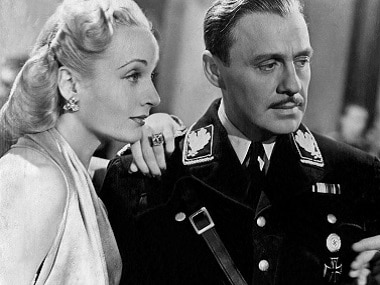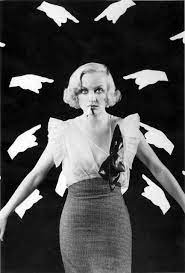Trigger warning – the Holocaust
To Be or Not to Be was one of the final films directed by Ernst Lubitsch, a German actor and filmmaker most famous for directing Ninotchka in 1939 and The Shop Around the Corner in 1940.[1] Lubitsch acted in around 30 silent films in Germany before moving to the US to found his own production company, where he shifted his focus to directing.
To Be or Not to Be is a dark comedy about a theatre troupe in Warsaw who work to stop a Nazi spy by impersonating sympathizers, fellow Nazis, and the spy himself. While the film was criticized upon its release for being in poor taste and had overall mixed reviews from critics, the film was selected by the Library of Congress to be preserved in 1996.[2]

To talk about To Be or Not to Be, we must acknowledge and analyse dark comedy as a subgenre, particularly as it pertains to subjects like war and peace. Obviously, dark comedy has been used famously in narratives with an anti-war agenda (Vonnegut’s Slaughterhouse-Five and Heller’s Catch-22 come to mind most readily, as well as M*A*S*H [1970] or Jojo Rabbit [2019] as examples of other films). However, To Be or Not to Be is unique in this subgenre in that its humour is not so sharp and politically directed as some of the examples listed above. This fact leaves the film open to criticism for being ‘insensitive’ or ‘blasé’ about such serious subjects as the Nazi occupation of Poland. In my view, however, that criticism is misaimed, since the film’s ‘gallows humour’ provides a sense of empowerment, resistance, and relief.

It’s been proven that humour is helpful in rehabilitation and recovery as well as in physical recovery and health, besides being recommended informally to help with anxiety and depression. In essence, comedy is good for you (with all the obvious caveats about it sometimes being offensive, and sometimes even triggering). Good health and war rarely coexist; besides physical injury and mental distress, disease and famine are regular companions of war, for both civilians and soldiers. While a meagre remedy for disease and stress, laughter can provide some respite in a war zone. And the ability not only to live but also to laugh in the face of aggression and invasion can also feel like (and be seen as) an act of defiance. Lubitsch’s play begins with the rehearsal of a satirical play about the Nazis, and laughter at the Nazis’ expense is near-constant from that point onward. In what is essentially the thesis of the film, Greenberg, one of the actors in the troupe, proclaims that ‘a laugh is nothing to be sneezed at’, and throughout the film as actors impersonate Nazis and spies and make small jabs at the soldiers’ expense, Lubitsch proves that in the face of occupation and annihilation, laughter certainly cannot be undervalued.
Of course, the production circumstances and Lubitsch’s own background and context must be taken into consideration when analysing this film. As noted above, Lubitsch was a Jewish immigrant from Germany, and this film can be read as a reaction to Nazi antisemitism and its ramifications during Germany’s occupation of other European countries. Lubitsch adapted the screenplay for To Be or Not to Be from a story by Melchior Lengyel, a Jewish Hungarian writer with whom Lubitsch had also worked to develop his films Ninotchka (1939) and Angel (1937). According to author Rick McCormick, Lubitsch also employed many Jewish set workers, most of whom had left Germany when living conditions became too dangerous. At least one character, Greenberg (who delivers the film’s thesis statement mentioned above), is identified very clearly as Jewish, delivering Shylock’s famous monologue from Shakespeare’s Merchant of Venice three times throughout the film and making a joke about keeping kosher no more than five minutes into the film (‘Rawitch, what you are, I wouldn’t eat’). These references, coupled with the religious backgrounds of many involved in the film’s production as well as the political backdrop against which the film is set, add an extra layer of defiance to the humour and laughs we see throughout the film. Not only do the victims of an occupied Poland laugh in the face of Nazi oppression, but so do the Jewish characters and creators whose very existence is threatened by Nazi agendas.

It is obviously difficult to differentiate between a narrative which is anti-war and one which is pro-peace: stories can be one but not the other, they can be both, or neither. However, a film like To Be or Not to Be, which is so focused on life and its continuation certainly has aims of survival, post-conflict recovery and peace at the forefront of its messaging. It is a film that visualises a future without Nazi oppression, and that enacts that reality on stage via exercising freedom of speech in its humorous satire. While this kind of peace-making uses active resistance as a means, the film focuses most of its attention on humour, well-being, and continued survival. In 1939, a group of Hasidic Jews in Poland were attacked by Nazis while singing, ‘Mir veln zey iberlebn, iberlebn, iberlebn’ (‘We will outlive them‘). Ernst Lubitsch’s protagonists laugh, dance, and sing the same thing. Though the circumstances and outcomes may differ, the message remains the same.
What do you think?
- How can acts of resistance contribute to conflict-resolution, peace-building or the visualisation of future peace?
- What is the role of humor/satire in acts of resistance and movements toward peace?
- Is it necessarily the job of the oppressed to defend themselves?
- What is the difference between a work that is anti-war and a work that is pro-peace?
If you enjoyed this item in our museum…
You might also enjoy ‘Mother Night‘, ‘Dad’s Army: Pockets of Peace and Humour?‘ and ‘JoJo Rabbit‘.
Arden Henley, April 2022
[1] For more information, see e.g.: Denslow, Kristin N. “‘Clearly It’s Nothing Alarming . . . It’s Only Shakespeare’: Conjuring the Shakespeare Specter in Ernst Lubitsch’s <em>To Be or Not To Be</Em>.” Shakespeare Bulletin 33, no. 3 (2015): 421–39; Gemünden, Gerd. “Space out of Joint: Ernst Lubitsch’s ‘To Be or Not to Be.’” New German Critique, no. 89 (2003): 59–80; Melehy, Hassan. “Lubitsch’s ‘To Be or Not to Be’: The Question of Simulation in Cinema.” Film Criticism 26, no. 2 (2001): 19–40; Whitfield, Stephen J. “On Sutak’s <em>Cinema Judaica: The War Years, 1939–1949</Em>.” Jewish Film & New Media 4, no. 2 (2016): 192–95.
[2] See e.g. https://www.nytimes.com/1942/03/07/archives/the-screen.html for an example of a criticism of the film.